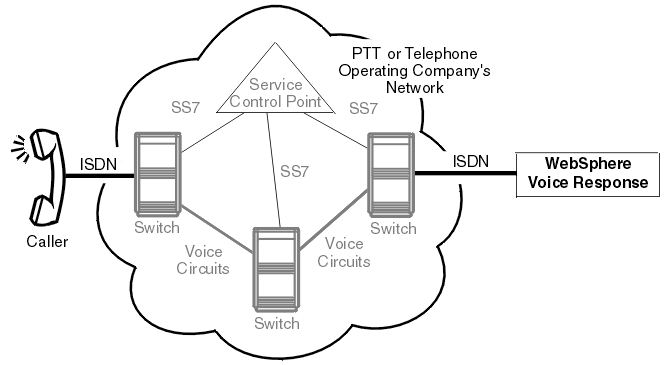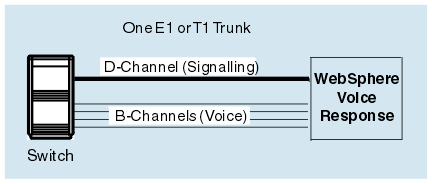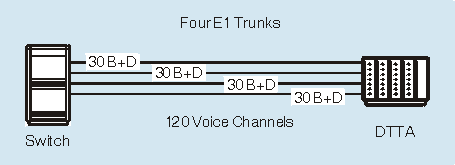The other way in which you can overcome the disadvantages of channel associated signaling protocols (see Disadvantages of channel associated signaling), is to use a common channel signaling (CCS) protocol. Common channel signaling avoids all these problems. Using short, fast messages that are sent (bidirectionally) down a single time slot of a trunk, the switch/network and the voice response unit can communicate much more efficiently than they can with a channel associated signaling trunk.
Blueworx Voice Response supports two types of common channel signaling protocol:
- Integrated Services Digital Network (ISDN)
- Signaling System 7 (SS7)
Blueworx Voice Response also supports the development of specialized common channel signaling protocols for intelligent network (IN) applications, through the use of the signaling interface.
Integrated Services Digital Network
In contrast to Signaling System 7, the ISDN primary rate interface (PRI) is designed as an access protocol, and is therefore also known as primary rate access (PRA).

An ISDN trunk is a T1 or E1 trunk with one of the timeslots dedicated to signaling; this timeslot is called the D-channel. (The D-channel signaling protocol is based on the ITU-T Q.921 and Q.931 recommendations.) The remaining timeslots are used for voice and are called B-channels (see Figure 2). ISDN trunks are generally used between an external subscriber and a switch within a network. ISDN will eventually displace channel associated signaling (that is, T1 and E1 trunks) as the means by which primary-rate subscribers attach to SS7-controlled networks.


In addition to being used as an access protocol, primary rate ISDN is used in the United States to attach intelligent peripherals within an operating company's advanced intelligent network (as shown in Figure 3). Blueworx Voice Response can either function as an intelligent peripheral, or provide voice processing function as part of a larger service node.
Advantages of ISDN
The usual reason for using ISDN is that it allows a single digital channel to be used for several different types of communication services, such as voice, X.25, video, and so on. However, for Voice Response Units such as Blueworx Voice Response, ISDN offers a further set of benefits, even if the Voice Response Unit is used only for voice:
- Reliable call setup and clearing
- Fast, reliable, delivery of called and calling number to the Voice Response Unit
ISDN protocols supported
The optional ISDN features support:
- Primary rate interface (PRI) vendor-specific implementations
- PRI switching and signaling capabilities
- Calling number identification services for PRI
An optional feature of Blueworx Voice Response allows you to connect to the network over an ISDN primary rate interface that conforms to each of the following protocols:
- Lucent 5ESS 5E8
- Lucent 5ESS 5E9 National 1
- Lucent TR41449/TR41459
- Nortel DMS100 BCS34/36
- Nortel DMS100 National 2 — NA015
- Nortel DMS250 — IEC05
- Lucent 5ESS 5E11–15 National ISDN2
- INS Net Service 1500
- Euro-ISDN
- E1 ISDN QSIG ECMA 143 and international standard ISO/IEC 11572:2000
The National ISDN effort is being driven by Bellcore and the Corporation for Open Systems, on behalf of the operating companies and the North American ISDN Users Forum (NIUF).
The functions provided by each standard are summarized in Table 1 . Table 2 shows how Blueworx Voice Response supports ISDN protocols.
- Lucent 5ESS 5E8
- 5ESS 5E8 is a custom protocol implemented by Lucent Technologies on 5ESS central office switches in the U.S. It provides 23B+D channels over a T1 facility.
- Lucent 5ESS 5E9 National 1
- 5ESS 5E9 is a custom protocol implemented by Lucent Technologies on 5ESS central office switches in the U.S. It provides 23B+D channels over a T1 facility.
- Lucent TR41449/TR41459
- TR41449 and TR41459 are the custom protocols implemented by Lucent Technologies on the Definity PABX and 4ESS switch for use with T1 facilities.
- Nortel DMS100 BCS34/36
- DMS100 BCS34 and BCS36 are custom protocols implemented by Nortel on DMS100 central office switches in the U.S. They provide 23B+D channels over a T1 facility.
- Nortel DMS100 National 2 NA015
- DMS100 National 2 NA015 is a custom protocol implemented by Nortel on DMS100 central office switches in the U.S. It provides channels over a T1 facility.
- Nortel DMS250 IEC05
- DMS250 IEC05 custom protocols implemented by Nortel on DMS250 central office switches in the U.S. It provides channels over a T1 facility.
- Lucent 5ESS 5E11–15 National ISDN2
- National ISDN2 is a common ISDN standard developed for use in the U.S. It provides 23B+D channels over a T1 facility. National ISDN-2 is supported on the Summa Four PBX switch and on the Lucent 5ESS switch with 5E12 protocol.
- INS Net Service 1500
- INS Net Service 1500 is an ISDN standard developed for use in Japan. It provides 23B+D channels over a T1 facility.
- Euro-ISDN
- Euro-ISDN is a common
European ISDN standard that provides 30B+D channels over an E1 facility.
Euro-ISDN services are available in seventeen countries in Europe
(including France, Germany, and the U.K.). Most of these countries
provide Euro-ISDN services for production use; in a few countries,
only pilot services are available. In some European countries, ISDN
is already the generally-accepted method of connecting telephony equipment
to the public network when multiple lines are required (and is tariffed
accordingly). Note: In some countries, a Euro-ISDN switch may send multiple channels in the Channel ID Information element of a RESTART message. If this occurs, Blueworx Voice Response only acknowledges the RESTART message if all the channels in the relevant trunk have had their operating status set to inservice. If the switch is configured in this manner, the Blueworx Voice Response ISDN Signaling system parameter Send RESTART on Channel Enable must be be set to No (refer to the Blueworx Voice Response for AIX: Configuring the System information for details).
- E1 QSIG
- E1 QSIG is specified by the ECMA-143 (International Standard ISO/IEC
11572), which defines the signalling procedures and protocol at the
Q-reference point between Private Integrated Network Exchanges (PINXs)
within a Private Services Network (PISN). The physical connection
must be an E1 telephony trunk.
Blueworx Voice Response is intended to be used either as the originating PINX or the terminating PINX and provides functionality to become a transit PINX.
Blueworx Voice Response QSIG also supports ECMA-242, which provides control for a Message Waiting Indicator (MWI) over the signaling D-Channel. MWI control can be invoked using the signaling library SL_STATION_SET_MWI_REQ primitive and supports the following states: SL_MWI_ON and SL_MWI_OFF. Refer to the Blueworx Voice Response for AIX: Programming for the Signaling Interface information for further information.
| Protocol |
Type |
Connectivity |
Function |
||||||
|---|---|---|---|---|---|---|---|---|---|
| In the Type column, Trunk means ‘trunk-side protocol’ and Line means ‘line-side protocol’. |
PSTN |
PABX |
Channel bank |
Answer detection |
Call transfer |
Far-end disconnect |
ANI |
DID or DNIS |
|
| Lucent 5ESS 5E8 |
Trunk |
Yes |
No |
Yes1 |
Yes |
No |
Yes |
Yes |
Yes |
| Lucent 5ESS 5E9 National 1 |
Trunk |
Yes |
No |
Yes1 |
Yes |
No |
Yes |
Yes |
Yes |
| Lucent TR41449/ 41459 |
Trunk |
No |
Yes |
Yes1 |
Yes |
No |
Yes |
Yes |
Yes |
| Nortel DMS100 BCS34/36 |
Trunk |
Yes |
No |
Yes1 |
Yes |
No |
Yes |
Yes |
Yes |
| Nortel DMS 100 National 2 NA015 |
Trunk |
Yes |
No |
Yes1 |
Yes |
Yes2 Yes3 |
Yes |
Yes |
Yes |
| Nortel DMS 250 IEC05 |
Trunk |
Yes |
No |
Yes1 |
Yes |
Yes2 Yes3 |
Yes |
Yes |
Yes |
| Lucent 5ESS 5E11–15 National ISDN2 |
Trunk |
Yes |
No |
Yes1 |
Yes |
Yes2 |
Yes |
Yes |
Yes |
| INS Net Service 1500 |
Trunk |
Yes |
Yes |
Yes1 |
Yes |
No |
Yes |
Yes |
Yes |
| Euro-ISDN |
Trunk |
Yes |
Yes |
– |
Yes |
Yes4 |
Yes |
Yes |
Yes |
| E1 QSIG |
Trunk |
No |
Yes |
No |
No |
Yes4 |
Yes |
Yes |
Yes |
| Note:
|
|||||||||
| ISDN Feature |
5ESS 5E8 |
5ESS 5E9 National 1 |
TR41449/ TR41459 |
DMS100 BCS34/36 |
DMS100 National |
DMS250 IEC05 |
5ESS 5E11–15 National 2 |
INS 1500 |
Euro-ISDN |
E1 QSIG |
|---|---|---|---|---|---|---|---|---|---|---|
| Network or User Side |
User Side only |
User Side only |
User Side only |
User Side only |
User Side only |
User Side only |
User Side only |
User Side only |
User Side only |
Endpinx User Side only |
| 3.1 KHz Audio Bearer Capability |
Yes |
Yes |
Yes |
Yes |
Yes |
Yes |
Yes |
Yes |
Yes |
Yes |
| 64 kbit Speech-Bearer Capability |
Yes |
Yes |
Yes |
Yes |
Yes |
Yes |
Yes |
Yes |
Yes |
Yes |
| Called and Calling Party Number1 |
Bway2 |
Bway |
Bway |
Bway |
Bway |
Bway |
Bway |
Bway |
Bway |
Bway |
| User-to-User signaling |
Yes |
Yes |
Yes |
Yes |
Yes |
Yes |
Yes |
Yes |
Yes |
No |
| Restart message support |
Bway2 |
Bway |
Bway |
Bway |
Bway |
Bway |
Bway |
Bway |
Bway |
Bway |
| B-channel Service Message Support |
– |
– |
Yes |
No |
Yes |
Yes |
Yes |
No |
– |
No |
| ETSI 300-062 to 064 Direct Dial In (DDI) |
– |
– |
– |
– |
– |
– |
– |
– |
Yes |
– |
| ETSI 300-050 to 052 Multiple Subscriber Number (MSN) |
– |
– |
– |
– |
– |
– |
– |
– |
Yes |
– |
| ETSI 300-367 to 369 Explicit Call Transfer (ECT) |
– |
– |
– |
– |
– |
– |
– |
– |
No |
No |
| ECMA-300 Single Step Call Transfer Supplementary Service (SSCT) |
– |
– |
– |
– |
– |
– |
– |
– |
Yes |
Yes |
| Bellcore GR- 2865 2 B-channel transfer |
– |
– |
– |
– |
Yes |
Yes |
Yes |
– |
– |
No |
| Release link trunk (RLT) transfer |
– |
– |
– |
– |
Yes |
Yes |
– |
– |
– |
No |
| Non-Facility Associated Signaling (NFAS) |
– |
Yes |
Yes |
Yes |
Yes |
Yes |
Yes |
Yes |
– |
No |
| D-channel backup |
– |
No |
Yes |
No |
Yes |
Yes |
Yes |
No |
– |
No |
| Bellcore TR-1268 Call by Call service selection |
No |
No |
No |
No |
No |
No |
No |
– |
– |
No |
| Note:
|
||||||||||
Non-Facility Associated Signaling
Blueworx Voice Response supports Non-Facility Associated Signaling (NFAS) on T1 systems. In the normal ISDN configuration, each T1 trunk has 23 bearer channels (B-channels) carrying voice traffic, and 1 signaling channel (D-channel) carrying signaling traffic. (23B+D).
In an NFAS configuration, the ISDN trunks are grouped into NFAS groups. You can define up to four NFAS groups on each pSeries computer with a maximum of 10 trunks in each group. The signaling traffic for all the trunks in a group is carried on one D-channel. The trunk that carries the signaling information on its 24th channel is called the primary trunk.
For some switches and line signaling protocols, you can also set aside a channel on another trunk in each group to act as a backup for the signaling channel. The backup D-channel does not carry voice and will automatically take over the signaling traffic if the primary D-channel goes out of service. The trunk that has its 24th channel on standby to carry the signaling information is called the backup trunk.
| Switch type | Line signaling | Custom server |
|---|---|---|
| Avaya (Lucent) 4ESS | TR41449 | sigproc_att_tr41449.imp |
| Avaya (Lucent) 5ESS – 2000 | ISDN National 2 | sigproc_t1_nat.imp |
| Avaya (Lucent) Definity G1/G2/G3 | TR41449 | sigproc_att_tr41449.imp |
| NT DMS 100 | ISDN National | sigproc_dms_nat.imp |
| NT DMS 250 | ISDN_IEC05 | sigproc_dms250.imp |
| Summa Four | ISDN National 2 | sigproc_t1_nat.imp |
| TR41449 | sigproc_att_tr41449.imp |
To illustrate the concept of non-facility associated signaling, Figure 4 and Figure 5 show how many voice channels you get with four E1 or T1 trunks. Figure 6 shows how many channels you get with four T1 trunks using NFAS. Figure 7 shows how many channels you get with four T1 trunks using NFAS with D-channel backup.




Key facts about ISDN support
- Blueworx Voice Response supports ISDN connectivity, giving customers the benefits of common channel signaling, such as very fast call setup and teardown, reliable network signaling, and the delivery of called and calling number information.
- Blueworx Voice Response supports voice calls on the B-channels, by using the speech and 3.1kHz bearer capabilities.
- Blueworx Voice Response protects customer investment in applications by allowing existing state tables to run unchanged over ISDN.
- Blueworx Voice Response supports a maximum of 480 concurrent voice channels with ISDN on E1 on PCI-based hardware.
- Blueworx Voice Response supports a maximum of 380 concurrent voice channels with ISDN on T1 on PCI-based hardware.
- Blueworx Voice Response supports up to four Non-Facility Associated Signaling (NFAS) groups on T1 systems, with a primary and a backup D-channel for up to 10 trunks in each group.
- Blueworx Voice Response supports the use of service maintenance messages to take individual channels out of service on T1 systems.
- Blueworx Voice Response supports the coexistence of ISDN trunks and channel associated signaling trunks in the same system for ease of migration.
- Blueworx Voice Response supports a number of key supplementary services.
- Blueworx Voice Response operates in Terminal Equipment (TE) mode.
Signaling System 7
Signaling System 7 (SS7) is the common channel signaling protocol that is used internally in telephone operators' digital communication networks. SS7 is not an access protocol, by which terminal equipment attaches to the network, but is used to attach voice response units, such as Blueworx Voice Response.
The SS7 protocol is implemented to ISUP specifications, which Blueworx Voice Response supports. The higher levels of the protocol have many local variations.


SS7 links and network components
SS7 uses discrete messages to exchange information. Packet-switched data links are used to send the messages between switches and the other end points. There are two types of connections in a telephony network:
- Packet switched links that are used for SS7 messages (but not voice data).
- Circuit switched links used for voice data (but not SS7 messages).
The SS7 protocol stack
SS7 is structured in a multi-layered stack that corresponds closely to the layers of the standard OSI model, although some SS7 components span several layers. SS7 supports the Integrated Services User Part (ISUP), which spans the presentation, session, and transport layers.
The ISUP handles the setup and tear-down of telephone calls and provides functions that are available with primary rate ISDN. These include called and calling number notification (or suppression), the ability to control billing (charging) rates, advanced telephony functions such as transfer, and control over whether the voice channel is used for voice, fax, or data.
ISUP messages flow only during the setup and tear-down phases of a call.
Communication between your SS7 switch and SS7 Server is determined by the existence of point codes. These are addresses that each side uses to send messages to the other. Each side has a concept of a Source Point Code (SPC) and a Destination Point Code (DPC). The SPC of your switch is the DPC of the SS7 Server; the SPC of SS7 Server is the DPC of your switch.